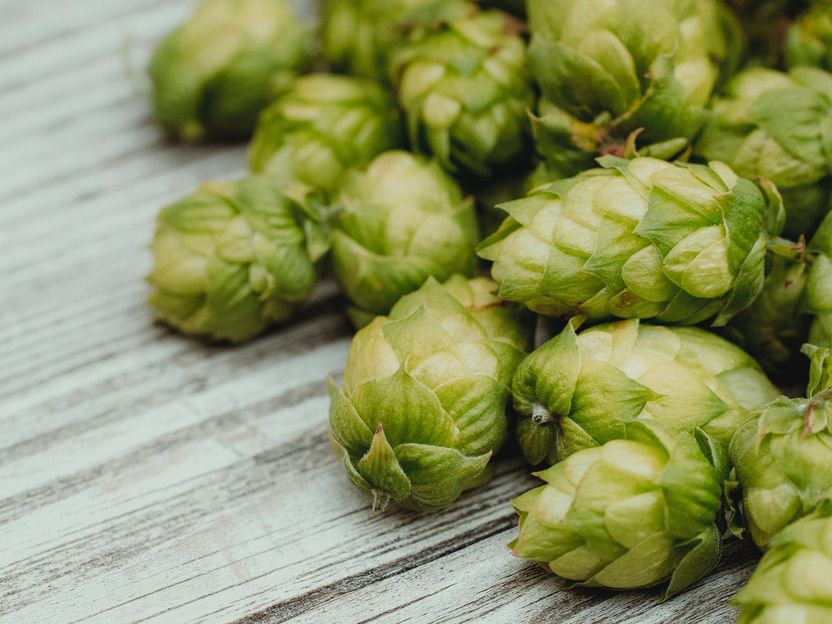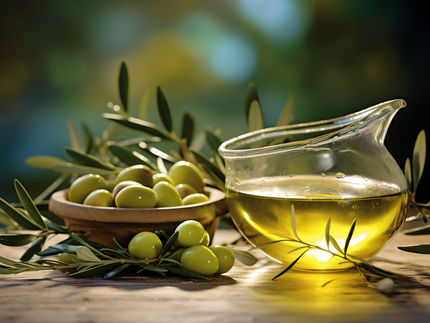Botanicals: These plants can complement a healthy diet
Advertisement
From artichoke to grape - we present plants that have been appreciated as food for generations and, thanks to their high-quality ingredients, are also used in dietary supplements.
Plants and plant preparations have always been part of man's diet . They are consumed in juices and salads, as tea, in spirits or as food seasonings, and are also available in concentrated form as dietary supplements. For example, around 17 percent of all dietary supplements sold in Germany contain one or more plant extracts, helping to supplement the diet with high-quality plant nutrients.
Plants provide people with important ingredients such as carbohydrates, protein and fat, as well as vitamins, minerals and, of course, water. In addition, they contain what are known as secondary plant compounds.

unsplash
What are secondary plant compounds?
Secondary plant substances are substances that are produced by plants and are therefore part of our daily diet . They give plant foods their color, serve the plants as defenses against predators or microbial attack, and also act as flavorings and messenger substances. To date, about 100,000 different secondary plant compounds are known, of which between 5,000 and 10,000 are found in human food. They are not counted among the essential nutrients for humans, but influence a large number of metabolic processes, which is why various health-promoting effects are being discussed.
18 exemplary plants
18 plants that are valued for their botanical ingredients and especially for their secondary plant compounds and are therefore also offered in concentrated form as dietary supplements are listed below.
1. artichoke
The artichoke (botanically: Cynara cardunculus) is a thistle-like plant with edible budded inflorescences. In particular, the artichoke hearts, which have a delicate bitter taste, are a popular food. Extracts of the artichoke leaves, which contain numerous secondary plant compounds, including derivatives of caffeoylquinic acid, as well as bitter compounds such as cynaropicrin and flavonoids (e.g., luteolin), are used primarily in dietary supplements.
2. valerian
Valerians(botanically: Valeriana officinalis) are shrubs and include about 150 to 200 plant species. The root of valerian is used, from which extract, powder, tincture or tea is usually obtained. Valerian root contains essential oil, which is composed of so-called monoterpenes, such as borneol and camphor, and sesquiterpenes, among others.
3. cranberry
Cranberries (botanically: Vaccinium macrocarpon) are said to take their name from the crane, whose beak the stamens of the flowers resemble. Their German name, Kranbeere or Moosbeere, however, is hardly known in our regions. They are related to the cranberries and contain a lot of vitamin C. In addition, they contain many secondary plant substances, especially proanthocyanidins.
4. ginkgo
Ginkgo (botanically: Gingko biloba) is a tree from Asia, which has been known there for thousands of years as a temple tree, food and medicinal plant. In the meantime it grows worldwide, also in Germany. It is extremely hardy and can live up to 1,000 years. Traditionally, ginger nuts are served on the plate. Roasted, they resemble the taste of pistachios, chickpeas or chestnuts; cooked, they taste slightly bitter. Tea and extract are obtained from the leaves. Gingko leaves contain the secondary plant compounds flavonoids (for example, quercetin), terpenoids, sitosterols and anthocyanins.
5. ginseng
Ginseng (botanically: Panax ginseng) is a tuber with similar origins to ginkgo. The plant originates from mountain forests of East Asia, where it thrives on shady slopes. In China, the roots have been used for over 2,000 years. The root consists of two to three percent of certain saponins, which include ginsenosides.
6. pomegranate
The pomegranate (botanically: Punica granatum), also known as fruit of the gods or fruit of paradise, is a member of the loosestrife family. It is said to have originated in Western or Central Asia and is mentioned in Greek mythology and religious writings. The fruits, or more precisely the seeds, are a popular food ingredient. The blood-red fruit contains minerals such as potassium and iron, as well as B vitamins. It also contains polyphenols and flavonoids, so-called antioxidants.
7. blueberry
Blueberries (botanically: Vaccinium myrtillus L.) are also known as blueberries, bickberries, ciderberries or dewberries. Bilberry extract is often used in dietary supplements. The berries are rich in vitamins C and E and contain many secondary plant compounds such as anthocyanins, which belong to the flavonoids. These belong to the pigments and are responsible for the dark coloration. Anthocyanins are also classified as antioxidants.
8. millet
Millet, one of the oldest cereals, belongs to the sweet grass family and is therefore naturally gluten-free. Millet is rich in magnesium, zinc, vitamin B1, vitamin B6, fluorine and silicon. In addition, 100 g of millet cover 55 percent of the daily iron requirement. Basically, it can be divided into two main groups: Sorghum millet with its larger grains on the one hand, and finer millet on the other. In food supplements, millet is used as panicle millet extract, golden millet extract and pearl millet extract.
9. true hops
The true hop (botanically: Humulus lupulus) is a climbing plant species from the hemp family. In cultivation, only female plants are cultivated, as the hop cone (botanically: Lupuli flos or Lupuli strobulus) is the relevant plant part. Hops contain the bitter substances humulone and lupulone, as well as up to 1.5 percent essential oils with sesquiterpene derivatives and flavonoids.
10. turmeric
Turmeric (botanically: Curcuma longa) belongs to the ginger family. The turmeric root has been used worldwide for thousands of years as a spice, but also as a dye and remedy. Turmeric is a main ingredient of curry powder and gives the spice mixture its typical color. The secondary plant substance curcumin is responsible for the ocher yellow to orange coloration.
11. pumpkin seeds
Pumpkins are among the most popular fall vegetables, peaking around Halloween. Best known is the garden squash (botanically: Cucurbita pepo). Pumpkin fruits are used to make delicious dishes such as pumpkin pie, pumpkin soup and more. And also the seeds, the pumpkin seeds, are interesting as food . In addition to vitamin E, selenium and the omega-6 fatty acid linoleic acid, they contain abundant plant sterols (phytosterols).
12. lavender
Lavender (botanically: Lavandula angustifolia) belongs to the labiates family. The flowers and the essential oils linalool and camphor, which are responsible for the specific smell of lavender, are used. Lavender flowers or leaves are also used in Mediterranean cuisine as a seasoning of sweet and salty dishes and are, for example, part of the herbs of Provence.
13. milk thistle
Milk thistle (botanically: Silybum marianum) is found mainly in the Mediterranean region. Here they grow on dry soils along roadsides and cattle pastures. The fruits of the milk thistle contain flavones, flavonoids, bitter substances, biogenic amines, tannins and colorants. The contained mixture of four secondary plant constituents, which belong to the family of flavolignans, is considered to be particularly valuable.
14 Lemon balm
Lemon balm (botanically: Melissa officinalis) belongs to the labiates and grows up to 80 centimeters high. The plant smells lemony, which is why it is also called lemon balm. The leaves are an enrichment of many dishes, for example as an ingredient in salads, pasta dishes or with fish. They provide an essential oil with fragrances such as citral, which are responsible for the citrus smell, with terpenes such as beta-caryophyllene and with tannins such as rosmarinic acid and caffeic acid.
15. passion flower
The passion flower (botanically: Passiflora incarnata L.) is a climbing plant. Its fruit, the passion fruit, is an edible berry with many seeds. However, the extracts of passionflower used for dietary supplements are obtained from its herb. Important ingredients of passionflower are mainly flavonoids, including vitexin and glycosides of apigenin and luteolin, as well as the substances isovitexin and shaftoside.
16. rosemary
Rosemary (botanically: Rosmarinus officinalis), is an evergreen semishrub belonging to the labiates family. In the European Middle Ages, rosemary was a symbol of love and has long been appreciated as a spice - especially in Mediterranean cuisine. Rosemary is a rich source of polyphenols, especially rosmarinic acid. Other ingredients include essential oils, flavonoids and triterpenes.
17. soybean
The soybean (botanically: Glycine max) belongs to the legume plant family. It has a high content of unsaturated fatty acids and is also a very good source of protein and fiber. In addition to omega-3 fatty acids, magnesium, iron, folic acid and vitamin C, soy scores particularly well with its isoflavone content. Chemically, isoflavones are similar in structure to the female sex hormone estrogen, which is why they are also known as phytoestrogens.
18. grapes
Grapes or grapes (botanically: Vitis vinifera) are the fruits of the grapevine, a climbing plant. They consist mainly of water and have a relatively high fructose content. However, they also provide valuable micronutrients such as vitamin A, vitamin B6 and vitamin C, iodine, folic acid and manganese, as well as secondary plant compounds. Polyphenols such as resveratrol and the flavonoids quercetin and myricetin are particularly worthy of mention here. Grape skin extract, grape seed extract and sometimes grapevine extract are used in dietary supplements.
What effects do plants and plant substances have on health?
The European Food Safety Authority (EFSA) is responsible for reviewing and approving health claims for foods. The claims approved to date (list) are mainly those relating to vitamins and minerals. The examination of the effect of plants and plant ingredients is still pending.
Note: This article has been translated using a computer system without human intervention. LUMITOS offers these automatic translations to present a wider range of current news. Since this article has been translated with automatic translation, it is possible that it contains errors in vocabulary, syntax or grammar. The original article in German can be found here.





























































